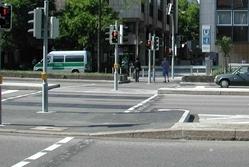Signalized Pedestrian Crossings on an Urban Highway in Stuttgart

The council of the Municipality of Stuttgart says YES to new signalized pedestrian crossings on an heavy loaded urban highway. After the one year test operation of the two signalized pedestrian crossings, they got now the “Go” for further operation.
The test operation of two signalized pedestrian crossings, which were newly built over the urban highway B 14 in Stuttgart, started in July 2006. The main aim was the harmonization of the traffic flow and the reduction of the traffic related emissions. To evaluate the effect of the traffic lights on the motorized traffic, the traffic related emissions and the number of pedestrians using the new crossings were observed in an intensive before and after investigation.In October 2007 the results of the investigation were published and presented to the council of the Municipality of Stuttgart. The main results of the before and after investigation are:The pedestrian crossings have no negative influence on the traffic flow on the B 14.1.500 and 1.000 pedestrians use the two signalized pedestrian crossings over the B 14 highway per day.The emissions in the area of the signalized pedestrian crossings remained on the same level as before or increased slightly, assumed the traffic volume remains constant.Actually the traffic volume of passenger cars remained on the same level as before but the volume of trucks decreased by 13%. The reduction of the volume of trucks caused a reduction of the emitted air pollutants as well. This positive effect is independent of the installation of the signalized pedestrian crossings, but mainly due to the city-wide ban of through traffic with heavy trucks (another CiViTAS-CARAVEL measure).Due to this convincing results the test operation was shifted in a permanent measure.
Author: Ulrich Vogt








